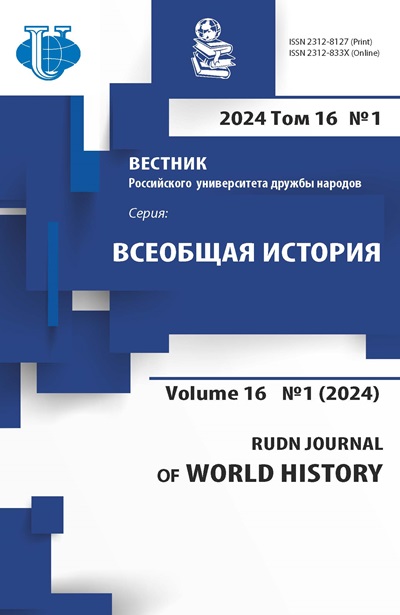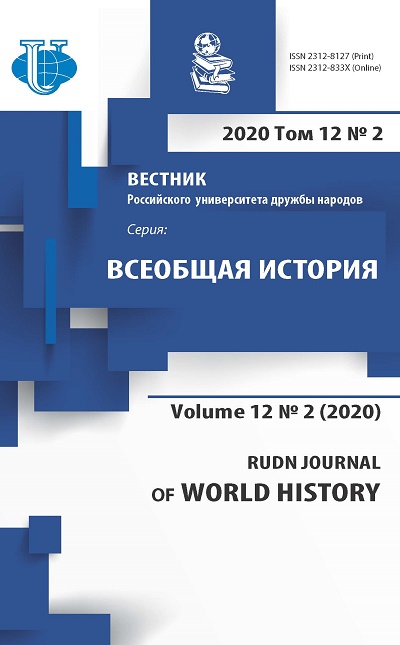The Buddhist factor in Oirat legislation
- Authors: Kitinov B.1
-
Affiliations:
- Institute of Oriental Studies Russian Academy of Sciences
- Issue: Vol 12, No 2 (2020)
- Pages: 169-185
- Section: Oriental Studies
- URL: https://journals.rudn.ru/world-history/article/view/24034
- DOI: https://doi.org/10.22363/2312-8127-2020-12-2-169-185
Cite item
Full Text
Abstract
The legislative acts, adopted by the Oirad in the middle of the XVII - the middle of the XVIII centuries, proceeded from the real external and internal political situation, depended on the influence of religious and social conditions. Laws of 1640 should be recognized as the most universally recognized and authoritative ones, since they were supposed to strengthen the relations of the Oirad with the Eastern Mongols, the unity (mutual assistance and interaction) of the Oirad in the conditions of the collapse of their former (Middle) Confederation. But it was precisely the consequences of the disintegration that necessitated the development of new, more “local” versions of laws, that have been adopted in Jungar (Decrees of Galdan Boshogtu-khan), Qoshut (“Mongolian code” of Gushi-khan, “Basic code of Kukunor chuulgan”), and later in Kalmyk (“Togtol”) khanates. Despite the fact that the Buddhist factor is reflected in pointed legislative acts quite clearly, religion is represented on a larger scale especially in Qoshut ones, which should be explained by the proximity of Tibetan sacred authorities to Qoshut people (Kukunor region) and the role of Qoshut “kings” (rgyal po). “Togtol” laws, adopted by the Kalmyk ruler Donduk-Dashi, also supplemented Laws of 1640, and marked the formation of a special community grouped around certain sacred texts.
About the authors
Baatr Kitinov
Institute of Oriental Studies Russian Academy of Sciences
Author for correspondence.
Email: histj@rudn.university
PhD, Associates Professor, Senior research fellow, Department of history of East
12, str.Rozhdestvenka str., Moscow, Russian Federation, 107031References
- Ledyard G. Two Mongol Documents from the Koryŏ sa // Journal of the American Oriental Society. April - June, 1963. Vol. 83. no 2.
- Rossabi M. The Golden Age of the Mongol Empire: Life and Time. St. Petersburg: Eurasia, 2009.
- Bichurin N.Ya. Historical review of Oirats or Kalmyks from the 15th century to the present. 2nd ed. Elista: Kalmyk Book Publishing House, 1991.
- Golstunsky K.F. Mongol-Oirat laws of 1640, additional decrees of the Galdan-hun-taiji and laws drawn up for the Volga Kalmyks under the Kalmyk Khan Donduk-Dasha. St. Petersburg, 1880.
- History of Kalmykia from ancient times to the present day. Elista: Publishing House “Gerel”, 2009. Vol. 1.
- Zlatkin I.Ya. History of the Jungar Khanate. 1635–1758. 2nd ed. M.: Nauka, 1983.
- Leontovich F. I. On the history of the law of Russian foreigners. The ancient Mongol-Kalmyk (Oirat) charter of penalties (Tsaajin Bichik). Odessa: Printed in G. Ulrich’s Tip., Krasny pereulok, house No. 3, 1879.
- Ryazanovsky V.A. Mongolian law (mostly customary). A Historical background. Harbin, 1931.
- Sazykin A.G. Ethical and legal principles of literature of “folk Buddhism” and Mongolian legal regulations of the 17th – 18th centuries // Lamaism in Kalmykia and issues of the scientific atheism. Elista: Publishing house of KNIIFE, 1980.
- Gurland Yа.I. Steppe legislation from ancient times to the XVII century. Kazan: Imp. Kazan. University Typ., 1904.
- Taupier Richard. The Oirad of the Early 17th Century: Statehood and Political Ideology. PhD. Diss. University of Massachusetts – Amherst, 2014.
- Sneath David. The Headless State: Aristocratic Orders, Kinship Society, and the Misrepresentation of Nomadic Inner Asia. Columbia University Press, 2007.
- Atwood Ch. Titles, appanages, marriages, and officials: a comparison of political forms in the Zunghar and Thirteenth Century Mongol empires // Imperial Statecraft: Political Forms and Techniques of Governance in Inner Asia, 6th–20th Centuries. Ed. by D. Sneath. Washington, 2006.
- Ikh Tsaaz. The Great code. Monument of Mongolian feudal law of the XVII century. Moscow: Nauka, 1981.
- Ishihama Yumiko. On the dissemination of the belief in the Dalai Lama as a manifestation of the Bodhisattva Avalokitesvara // The History of Tibet. Vol. II. The Medieval Period: c. 850–1895. The development of Buddhist Paramountcy. Ed. by Alex McKay. RoutledgeCurzon, 2003.
- Tsengel H. «Алтан хааны цаазын бичиг» хийгээд Гууш хааны «Цаазын бичиг»-ийн харьцаа, холбогдол // Ойрад ба дээд монголын туух, сурвалж бичгийн судлал. Улаанбаатар: Соембо принтинг, 2017. (“Tsajin Bichig” of Altan Khan and “Tsajin Bichig” of Gushi Khan: Comparison // Source Studies and History of Oirats and Upper Mongols).
- Kadyrbaev A.Sh. Legal and cultural interrelations of Kalmyks of Dzungaria and Volga region, Khalkhas with Kazakhs: XVII–XVIII centuries // Bulletin of the Kalmyk Institute for Humanitarian Studies of the Russian Academy of Sciences. 2017. Vol. 33. Is. 5.
- Materials on the history of Russian-Mongolian relations (MHRMR). 1654–1685. M.: Nauka, 1996.
- Tserenbal Gu., Tsengal Hoshuud. Хох нуурын чуулганы цаазын бичиг. Улаанбаатар, 2018. 412 p. (“Tsajin Bichig” of the Kukunor Chuulgan).
- Ngag dbang blo bzang rgya mtshos mdzad. Rgyal dbang lnga pa ngag dbang blo bzang rgya mtsho’i rnam thar du ku la’i gos bzang. Lhasa: Bod ljongs mi dmangs dpe skrun khang, 2012, vol. 1. 640 p. (Автобиография Далай-ламы Пятого).
- Meng-gu-yu-mu-ji (Notes on the Mongol nomads) / Transl. by P.S. Popov. SPb.: Skoropech. of P.O. Yablonsky, 1895.
- Shakabpa V.D. Zepon. Tibet. A Political history. St. Petersburg: Nartang, 2003.
- Petech L. Notes on Tibetan History of the 18th Century // T’oung Pao, Second Series. 1966. Vol. 52, Livr. 4/5.
- Archive of the Foreign Policy of the Russian Empire (AFPRE). Fund 119 “The Kalmyk files”. List 119/1. Case 40.1736.
- AFPRE. Fund 119 “The Kalmyk files”. List 119/1. Case 23. 1745–1746.
- Kurapov A.A. Legislative activity of the Kalmyk Buddhist clergy (XVII–XIX centuries) // Bulletin of the Ural State University. Ser. 1. Problems of education, science and culture. 2010. No. 6 (85), part 2.
- Meditations on the Lower Tantras. A Stairway for Ascending to Tusita Buddha-field. From the Collected Works of the II, V, VII and XIII Dalai Lamas. Compiled and edited by Glenn H. Mullin. Dharamsala: LTWA, 1983.
- Skrynnikova T.D. The Role of Buddhism in the Formation of Political Ideas in Mongolia of the 13th – 18th Centuries // Methodological Aspects of Studying the History of the Oriental Spiritual Culture. Ulan-Ude: BION SB AS USSR, 1988.
- Kozin S.A. The Inmost legend. The Mongolian Chronicle of 1240 “Yuan Chao Bi Shi”. Moscow-Leningrad: Publishing house of the USSR Academy of Sciences, 1941.
- Krueger R. John. Poetical passages in the Erdeni-yin Tobci. A Mongolian Chronicle of the year 1662 by Sagang Secen. Mouton & Co, 1961.
- Kitinov B.U. The Sacred Tibet and the warlike steppe: Buddhism among Oirad (XIII–XVII centuries). M.: KMK publications, 2004.
- Norbo S. Zaya-Pandita (Materials for Biography). Elista: Kalmyk Book Publishing House, 1999.
- AWPRI. Fund 119 “The Kalmyk files”. List 119/2. Book 2. 1732–1773.
- Palmov N.N. Studies on the history of the Volga Kalmyks. Part II Astrakhan: Publishing House of the Kalmoblispolkom, 1927.













